Unit 4 Behind beliefs Grammar and usage 课件(37张PPT)
文档属性
| 名称 | Unit 4 Behind beliefs Grammar and usage 课件(37张PPT) |

|
|
| 格式 | zip | ||
| 文件大小 | 776.0KB | ||
| 资源类型 | 教案 | ||
| 版本资源 | 牛津译林版 | ||
| 科目 | 英语 | ||
| 更新时间 | 2020-03-02 10:04:21 | ||
图片预览

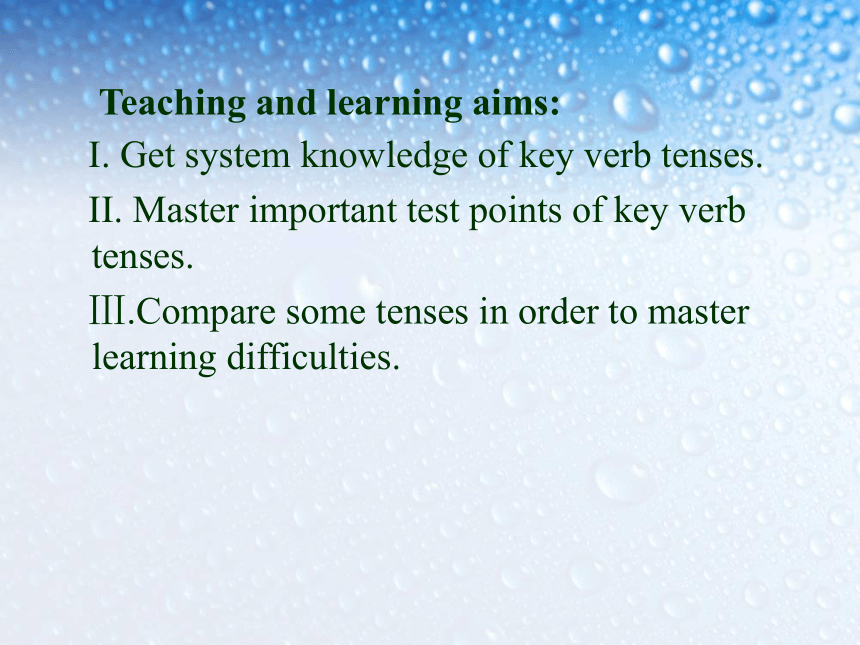
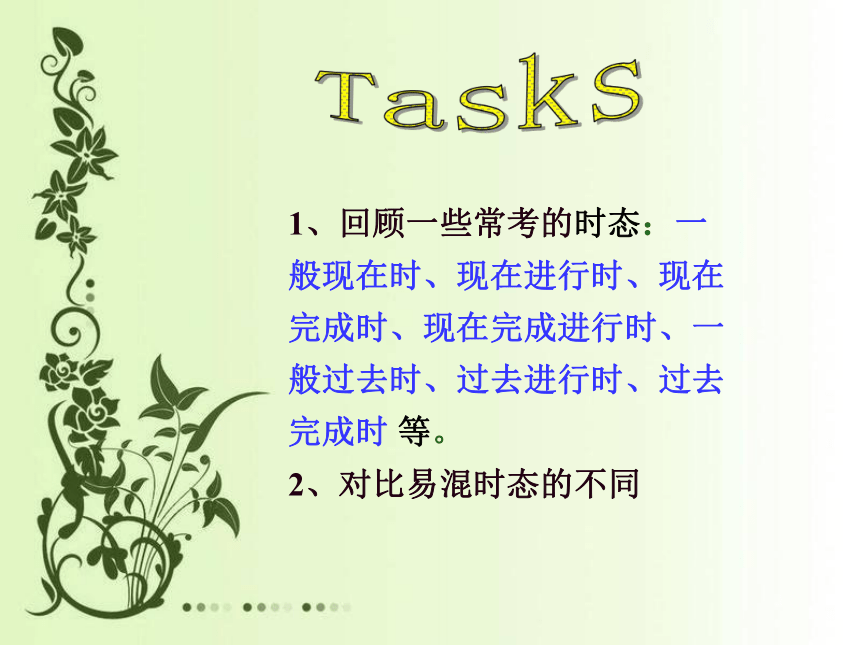
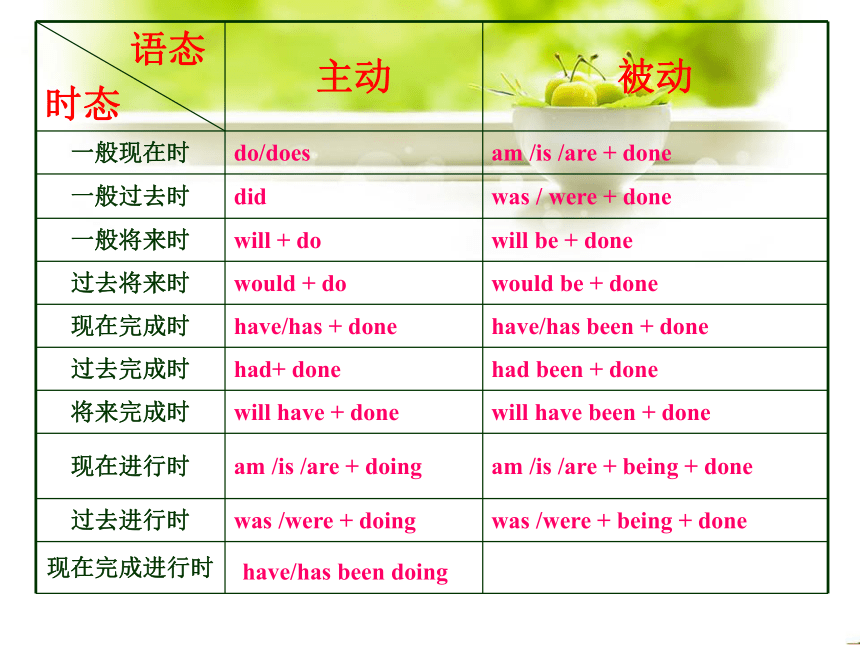
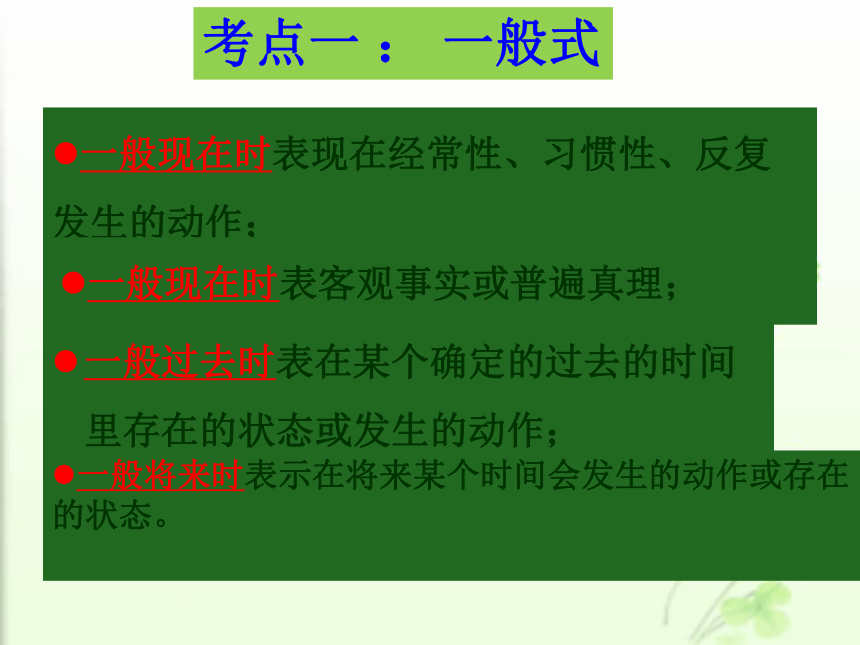
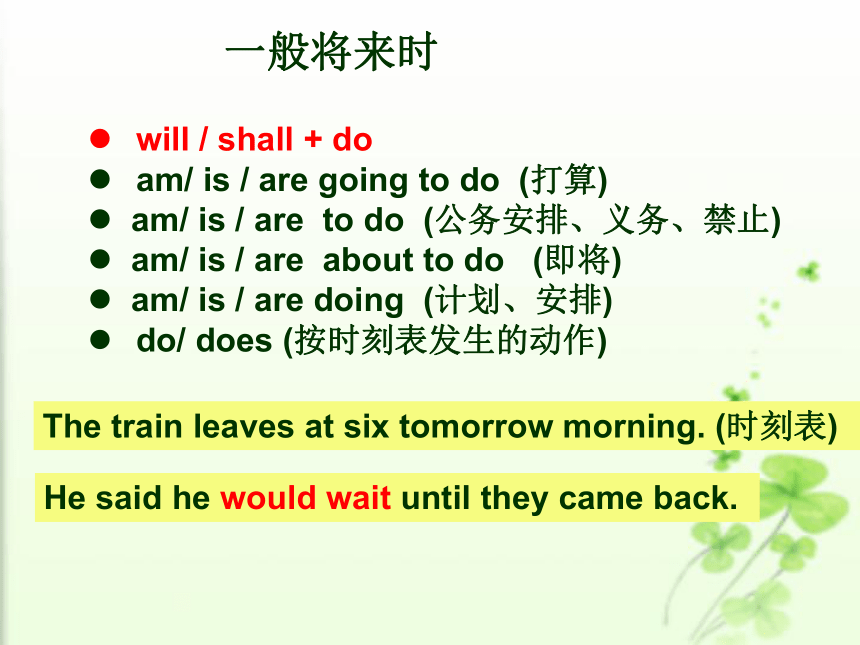

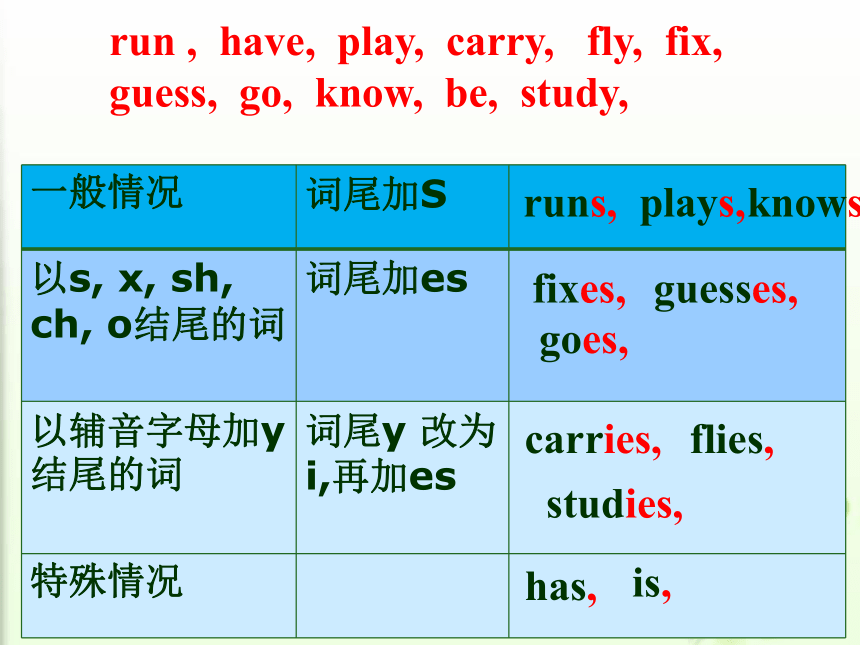
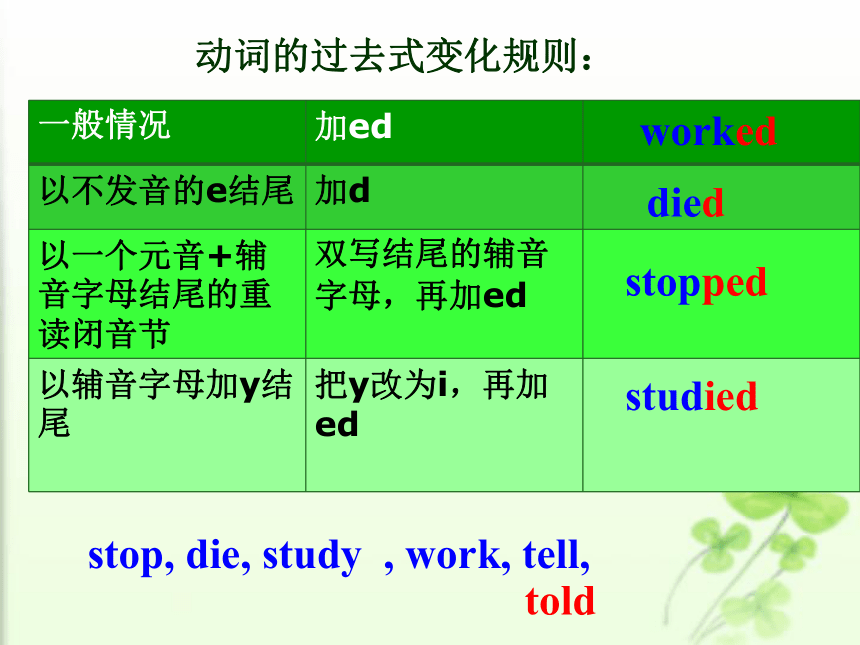
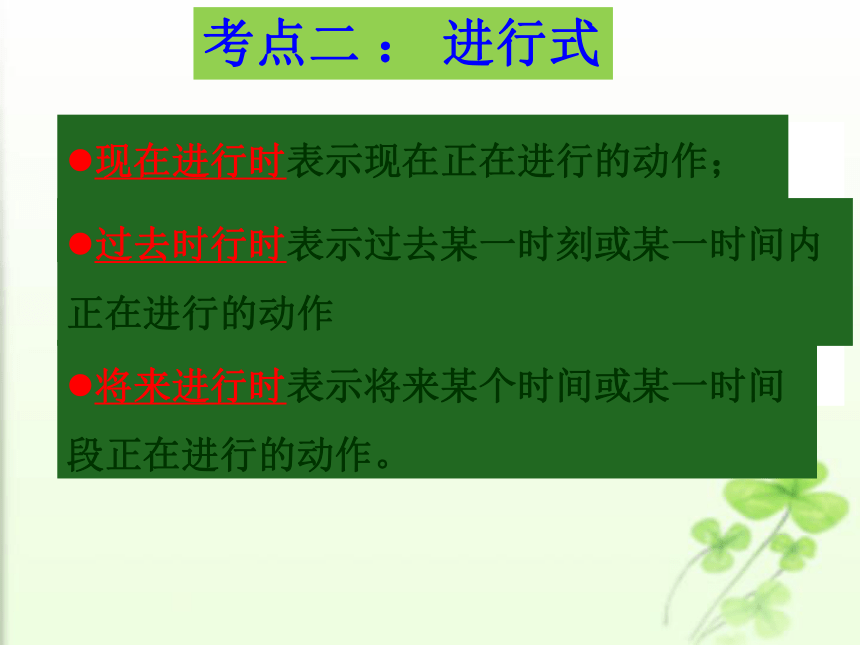


文档简介
(共38张PPT)
Teaching and learning aims:
I. Get system knowledge of key verb tenses.
II. Master important test points of key verb tenses.
Ⅲ.Compare some tenses in order to master learning difficulties.
1、回顾一些常考的时态:一般现在时、现在进行时、现在完成时、现在完成进行时、一般过去时、过去进行时、过去完成时 等。
2、对比易混时态的不同
have/has been doing
注意:时态语态不分家
语态
时态 主动 被动
一般现在时 do/does am /is /are + done
一般过去时 did was / were + done
一般将来时 will + do will be + done
过去将来时 would + do would be + done
现在完成时 have/has + done have/has been + done
过去完成时 had+ done had been + done
将来完成时 will have + done will have been + done
现在进行时 am /is /are + doing am /is /are + being + done
过去进行时 was /were + doing was /were + being + done
现在完成进行时
考点一 : 一般式
I often __________(memorize)words in the morning.
Actions ______(speak )louder than words.
He _____ (come)here three days ago.
will play
Tom________(play) football with us tomorrow.
came
memorize
speak
一般现在时表现在经常性、习惯性、反复发生的动作;
一般现在时表客观事实或普遍真理;
一般过去时表在某个确定的过去的时间里存在的状态或发生的动作;
一般将来时表示在将来某个时间会发生的动作或存在的状态。
一般将来时
will / shall + do
am/ is / are going to do (打算)
am/ is / are to do (公务安排、义务、禁止)
am/ is / are about to do (即将)
am/ is / are doing (计划、安排)
do/ does (按时刻表发生的动作)
The train leaves at six tomorrow morning. (时刻表)
He said he would wait until they came back.
谓语动词第三人称单数词尾的变化!
记住:一般现在时,第三人称单数时,谓语动词要加S,其他人称用原形。
run , have, play, carry, fly, fix,
guess, go, know, be, study,
runs,
has,
plays,
carries,
flies,
fixes,
guesses,
goes,
knows,
is,
studies,
一般情况 词尾加S
以s, x, sh, ch, o结尾的词 词尾加es
以辅音字母加y结尾的词 词尾y 改为i,再加es
特殊情况
动词的过去式变化规则:
stop, die, study , work, tell,
stopped
died
studied
worked
told
一般情况 加ed
以不发音的e结尾 加d
以一个元音+辅音字母结尾的重读闭音节 双写结尾的辅音字母,再加ed
以辅音字母加y结尾 把y改为i,再加ed
Don’t make so much noise, He___________(sleep).
We _________(have)dinner when they came.
I ___________class at 3 o’clock tomorrow.
考点二 : 进行式
is sleeping
were having
will be having
现在进行时表示现在正在进行的动作;
过去时行时表示过去某一时刻或某一时间内正在进行的动作
将来进行时表示将来某个时间或某一时间段正在进行的动作。
考点三 : 完成式
1. I _________(be)a teacher for over ten years.
2. When I got there, the train_______(leave).
3. We _______________(finish)the project by
the end of this year.
have been
had left
will have finished
现在完成时表示过去发生的动作或状态对现在产生的影响或结果;强调产生的影响或结果,译为“已经……”
过去完成时表在过去某一时刻以前已经完成的动作;
将来完成时在将来某个时刻前将要完成的动作,常与by(the end of)+将来时间连用
2.注意主动形式表示被动意义的4种情况
主语+连系动词(smell, feel, sound, taste,
become, prove等)+形容词
The plan sounds reasonable.
主语+表主语属性特征的词(sell, read, wash,
write, operate)+well, easily, badly等
The pen writes well.
get +过去分词, 表示被动
She got paid before she went on holiday.
解题思路
一、找时间状语
二、看已有谓语动词
三、理解语境
规律总结:
1.表示现在的状态,经常性、习惯性的动作,常连用的时间状语有
动词的时态 ( Tenses)
Fill in the blanks.
1.I _____ (study) hard abroad every day and I _____ (get) along well with my roommates, but sometimes I _____ (miss) my families.
study
get
miss
一.一般现在时 ( The Present Indefinite )
always, often/ usually/frequently, sometimes, every…, at …,on Sundays….
Correct the sentence.
2.The geography teacher told us that the earth moved around the sun. _______
规律总结:
2.表客观事实、普遍真理。
moves
1.As long as it___________ (rain) tomorrow, we'll have a trip on schedule.
2.(2014大纲卷)Unless extra money____, the theatre will close.
A. was found B. finds
C. is found D. found
规律总结:
3.在时间、条件或让步状语从句中,常用一般现在时替代一般将来时。
doesn’t rain
4.The shop will close at 9:00 p.m. _____
The train leaves at 6 tomorrow morning.
规律总结:
4. 表示按规定的时刻表将要发生的动作或存在的状态, 限于动词 come, go, start, begin, leave, arrive, return等,常与时间状语连用.
closes
四.现在进行时(The Present Continuous Tense)
1.Hurry up, kids!The school bus _________ (wait) for us!(2013?四川高考)
is waiting
2.She ___________ (learn) piano under Mr. Smith
at present.
is learning
表示说话时或现阶段正在进行的事情。
现在进行时的标志:
Now, right now, at this moment, look, listen…
Translate the sentence.
这个女孩老是在公共场所高谈阔论。
The girl is always talking loud in public.
★2.进行时态与always, often/usually/ frequently/ constantly/all the time等频度副词连用,表经常反复的行动或说话人赞叹或厌恶等感彩 .
3) 现在进行时用来表示按人为计划安排即将发生的动作,多用于位移/终止性动词,如: come, go, arrive, leave, stay, fly, take off.
I____________ (leave) tomorrow.
_____ you _______ (stay) here till next week?
am leaving
Are
staying
“The moment ______________ (come) soon,” he thought to himself, waiting nervously.(2012?湖南高考)
is coming
易混点1一般现在时与现在进行时的比较
1. On the wall _______( hang) a picture painted by Qi Baishi.
This is not my coat. Mine___________ ( hang) behind the door.
2.(2013·北京高考)Hurry up! Mark and Carol ______ us.
A.expect B.are expecting
C.have expected D.will expect
3.(2013·陕西高考)On Monday mornings it usually ________ me an hour to drive to work although the actual distance is only 20 miles.
A.takes B.is taking
C.took D.will take
hangs
is hanging
Correct the sentence.
All the students here is belonging to
No.1 Middle School. ________
belong
一般现在时表示经常性的、习惯性的动作或状态性的行为。 而现在进行时则具有进行性、未完成性和暂时性的特点。
二.一般过去时 ( The Simple Past Tense )
1.表过去发生了的动作或存在的状态。
常与表过去的时间连用。如 yesterday, last …, … ago, then, just now,
the other day, in the past, in +过去的时间(1990)等。
I _______ (spend) my childhood happily with my old friends in the countryside
several years ago.
spent
注意:
2.表示说话人始料未及的事情 ,要用一般过去时,这类动词有know ,expect ,think等。
I didn’t know it was you.
I ___________ (expect) to meet you here.
I think the film was interesting, but it isn’t.
————
thought
didn’t expect
1.Sorry ,your phone number again .I
___________ (catch) it.
2.--- Nancy is not coming tonight.
--- But she _____!
A. promises B. promised
C. will promise D. had promised
B
3.语境暗示,没有明确的表示过去的时间状语,但实际上指的是过去发生的动作或状态。
didn’t catch
现在完成时(The present Perfect Tense)
1. 现在完成时表示从过去开始,一直延续到
现在的动作或状态, 通常用于延续性动词.
常与表一段时间的状语连用,如:
He __________ (live) in Guiyang over the past
6 years.
has lived
lately,recently,in/over/during the last/past few days /years,since then,up to now/till,so far,for a long time.
2.表示过去的某一动作对现在造成的影响
或结果,常用的时间状语有: just ,already, yet,
ever, never等.
We ____________ (finish) our lunch already.
______ you ever ______ (try) this method?
have finished
Have
tried
3. 固定的特殊句型:
1).It is (has been) +一段时间 +since-clause.
2)This (That/It) is the first (second…) time + that-clause (现在完成时).
I_________ (stay) in Beijing for five days.Then I went to America.
I _____________ (stay) in Beijing for five days and haven't decided where to go next.
stayed
have stayed
易混点2 一般过去时与现在完成时的比较
一般过去时所表达的事件与现在无关,
而现在完成时则强调对现在的影响和结果。
3.It was at 3 o’clock ________he got home .
4.It was 3 o’clock _________he got home .
典题:
1.It is 3 years ____ he got the job.
A that B when
C since D before
when
that
before
对比反思:
2.It was 3 years _______he got home .
1. 表示某一动作或存在的状态发生在过去某一时间或某一动作之前,即“过去的过去”。一定有一个表示过去的参照点,这种时态从不孤立使用。常和by, by the end, by the time, until, before(后接表示过去某一时间或动作)连用。
By the end of last month we have finished all the work.. _______
had
过去完成时?(The past perfect Tense)
We arrived earlier than we _______________ (expect).
had expected
2.表示未曾实现的愿望、打算、意图、承诺等。常用had hoped / planned / meant / intended / thought / wanted / expected(+that…/to do)
I ____________ (intend) to call on you, but I had an unexpected visitor.
had intended
We had no sooner been seated than the bus started.
= Hardly/Scarcely _____ we been seated when the bus started.
= The bus started as soon as we were seated.
had
3.Hardly/scarcely…过去完成时+when …一般过去时
No sooner…过去完成时+than…一般过去时
判断是不是过去完成时应先从时间轴上找到表示“过去”的时间点或动作①,然后判断在这个时间点或动作之前还有没有另一个动作②,并且判断该句是否强调②发生在①前。
现在完成进行时
现在完成进行时表示从过去开始的一个动作一直持续到现在,而且还在进行当中。
强调的是“从过去到现在一直在进行”。
①The manager has been telling the workers how to improve the program since 9 am.(2012·全国卷Ⅱ)
②You have been saying you can succeed for five years.
Teaching and learning aims:
I. Get system knowledge of key verb tenses.
II. Master important test points of key verb tenses.
Ⅲ.Compare some tenses in order to master learning difficulties.
1、回顾一些常考的时态:一般现在时、现在进行时、现在完成时、现在完成进行时、一般过去时、过去进行时、过去完成时 等。
2、对比易混时态的不同
have/has been doing
注意:时态语态不分家
语态
时态 主动 被动
一般现在时 do/does am /is /are + done
一般过去时 did was / were + done
一般将来时 will + do will be + done
过去将来时 would + do would be + done
现在完成时 have/has + done have/has been + done
过去完成时 had+ done had been + done
将来完成时 will have + done will have been + done
现在进行时 am /is /are + doing am /is /are + being + done
过去进行时 was /were + doing was /were + being + done
现在完成进行时
考点一 : 一般式
I often __________(memorize)words in the morning.
Actions ______(speak )louder than words.
He _____ (come)here three days ago.
will play
Tom________(play) football with us tomorrow.
came
memorize
speak
一般现在时表现在经常性、习惯性、反复发生的动作;
一般现在时表客观事实或普遍真理;
一般过去时表在某个确定的过去的时间里存在的状态或发生的动作;
一般将来时表示在将来某个时间会发生的动作或存在的状态。
一般将来时
will / shall + do
am/ is / are going to do (打算)
am/ is / are to do (公务安排、义务、禁止)
am/ is / are about to do (即将)
am/ is / are doing (计划、安排)
do/ does (按时刻表发生的动作)
The train leaves at six tomorrow morning. (时刻表)
He said he would wait until they came back.
谓语动词第三人称单数词尾的变化!
记住:一般现在时,第三人称单数时,谓语动词要加S,其他人称用原形。
run , have, play, carry, fly, fix,
guess, go, know, be, study,
runs,
has,
plays,
carries,
flies,
fixes,
guesses,
goes,
knows,
is,
studies,
一般情况 词尾加S
以s, x, sh, ch, o结尾的词 词尾加es
以辅音字母加y结尾的词 词尾y 改为i,再加es
特殊情况
动词的过去式变化规则:
stop, die, study , work, tell,
stopped
died
studied
worked
told
一般情况 加ed
以不发音的e结尾 加d
以一个元音+辅音字母结尾的重读闭音节 双写结尾的辅音字母,再加ed
以辅音字母加y结尾 把y改为i,再加ed
Don’t make so much noise, He___________(sleep).
We _________(have)dinner when they came.
I ___________class at 3 o’clock tomorrow.
考点二 : 进行式
is sleeping
were having
will be having
现在进行时表示现在正在进行的动作;
过去时行时表示过去某一时刻或某一时间内正在进行的动作
将来进行时表示将来某个时间或某一时间段正在进行的动作。
考点三 : 完成式
1. I _________(be)a teacher for over ten years.
2. When I got there, the train_______(leave).
3. We _______________(finish)the project by
the end of this year.
have been
had left
will have finished
现在完成时表示过去发生的动作或状态对现在产生的影响或结果;强调产生的影响或结果,译为“已经……”
过去完成时表在过去某一时刻以前已经完成的动作;
将来完成时在将来某个时刻前将要完成的动作,常与by(the end of)+将来时间连用
2.注意主动形式表示被动意义的4种情况
主语+连系动词(smell, feel, sound, taste,
become, prove等)+形容词
The plan sounds reasonable.
主语+表主语属性特征的词(sell, read, wash,
write, operate)+well, easily, badly等
The pen writes well.
get +过去分词, 表示被动
She got paid before she went on holiday.
解题思路
一、找时间状语
二、看已有谓语动词
三、理解语境
规律总结:
1.表示现在的状态,经常性、习惯性的动作,常连用的时间状语有
动词的时态 ( Tenses)
Fill in the blanks.
1.I _____ (study) hard abroad every day and I _____ (get) along well with my roommates, but sometimes I _____ (miss) my families.
study
get
miss
一.一般现在时 ( The Present Indefinite )
always, often/ usually/frequently, sometimes, every…, at …,on Sundays….
Correct the sentence.
2.The geography teacher told us that the earth moved around the sun. _______
规律总结:
2.表客观事实、普遍真理。
moves
1.As long as it___________ (rain) tomorrow, we'll have a trip on schedule.
2.(2014大纲卷)Unless extra money____, the theatre will close.
A. was found B. finds
C. is found D. found
规律总结:
3.在时间、条件或让步状语从句中,常用一般现在时替代一般将来时。
doesn’t rain
4.The shop will close at 9:00 p.m. _____
The train leaves at 6 tomorrow morning.
规律总结:
4. 表示按规定的时刻表将要发生的动作或存在的状态, 限于动词 come, go, start, begin, leave, arrive, return等,常与时间状语连用.
closes
四.现在进行时(The Present Continuous Tense)
1.Hurry up, kids!The school bus _________ (wait) for us!(2013?四川高考)
is waiting
2.She ___________ (learn) piano under Mr. Smith
at present.
is learning
表示说话时或现阶段正在进行的事情。
现在进行时的标志:
Now, right now, at this moment, look, listen…
Translate the sentence.
这个女孩老是在公共场所高谈阔论。
The girl is always talking loud in public.
★2.进行时态与always, often/usually/ frequently/ constantly/all the time等频度副词连用,表经常反复的行动或说话人赞叹或厌恶等感彩 .
3) 现在进行时用来表示按人为计划安排即将发生的动作,多用于位移/终止性动词,如: come, go, arrive, leave, stay, fly, take off.
I____________ (leave) tomorrow.
_____ you _______ (stay) here till next week?
am leaving
Are
staying
“The moment ______________ (come) soon,” he thought to himself, waiting nervously.(2012?湖南高考)
is coming
易混点1一般现在时与现在进行时的比较
1. On the wall _______( hang) a picture painted by Qi Baishi.
This is not my coat. Mine___________ ( hang) behind the door.
2.(2013·北京高考)Hurry up! Mark and Carol ______ us.
A.expect B.are expecting
C.have expected D.will expect
3.(2013·陕西高考)On Monday mornings it usually ________ me an hour to drive to work although the actual distance is only 20 miles.
A.takes B.is taking
C.took D.will take
hangs
is hanging
Correct the sentence.
All the students here is belonging to
No.1 Middle School. ________
belong
一般现在时表示经常性的、习惯性的动作或状态性的行为。 而现在进行时则具有进行性、未完成性和暂时性的特点。
二.一般过去时 ( The Simple Past Tense )
1.表过去发生了的动作或存在的状态。
常与表过去的时间连用。如 yesterday, last …, … ago, then, just now,
the other day, in the past, in +过去的时间(1990)等。
I _______ (spend) my childhood happily with my old friends in the countryside
several years ago.
spent
注意:
2.表示说话人始料未及的事情 ,要用一般过去时,这类动词有know ,expect ,think等。
I didn’t know it was you.
I ___________ (expect) to meet you here.
I think the film was interesting, but it isn’t.
————
thought
didn’t expect
1.Sorry ,your phone number again .I
___________ (catch) it.
2.--- Nancy is not coming tonight.
--- But she _____!
A. promises B. promised
C. will promise D. had promised
B
3.语境暗示,没有明确的表示过去的时间状语,但实际上指的是过去发生的动作或状态。
didn’t catch
现在完成时(The present Perfect Tense)
1. 现在完成时表示从过去开始,一直延续到
现在的动作或状态, 通常用于延续性动词.
常与表一段时间的状语连用,如:
He __________ (live) in Guiyang over the past
6 years.
has lived
lately,recently,in/over/during the last/past few days /years,since then,up to now/till,so far,for a long time.
2.表示过去的某一动作对现在造成的影响
或结果,常用的时间状语有: just ,already, yet,
ever, never等.
We ____________ (finish) our lunch already.
______ you ever ______ (try) this method?
have finished
Have
tried
3. 固定的特殊句型:
1).It is (has been) +一段时间 +since-clause.
2)This (That/It) is the first (second…) time + that-clause (现在完成时).
I_________ (stay) in Beijing for five days.Then I went to America.
I _____________ (stay) in Beijing for five days and haven't decided where to go next.
stayed
have stayed
易混点2 一般过去时与现在完成时的比较
一般过去时所表达的事件与现在无关,
而现在完成时则强调对现在的影响和结果。
3.It was at 3 o’clock ________he got home .
4.It was 3 o’clock _________he got home .
典题:
1.It is 3 years ____ he got the job.
A that B when
C since D before
when
that
before
对比反思:
2.It was 3 years _______he got home .
1. 表示某一动作或存在的状态发生在过去某一时间或某一动作之前,即“过去的过去”。一定有一个表示过去的参照点,这种时态从不孤立使用。常和by, by the end, by the time, until, before(后接表示过去某一时间或动作)连用。
By the end of last month we have finished all the work.. _______
had
过去完成时?(The past perfect Tense)
We arrived earlier than we _______________ (expect).
had expected
2.表示未曾实现的愿望、打算、意图、承诺等。常用had hoped / planned / meant / intended / thought / wanted / expected(+that…/to do)
I ____________ (intend) to call on you, but I had an unexpected visitor.
had intended
We had no sooner been seated than the bus started.
= Hardly/Scarcely _____ we been seated when the bus started.
= The bus started as soon as we were seated.
had
3.Hardly/scarcely…过去完成时+when …一般过去时
No sooner…过去完成时+than…一般过去时
判断是不是过去完成时应先从时间轴上找到表示“过去”的时间点或动作①,然后判断在这个时间点或动作之前还有没有另一个动作②,并且判断该句是否强调②发生在①前。
现在完成进行时
现在完成进行时表示从过去开始的一个动作一直持续到现在,而且还在进行当中。
强调的是“从过去到现在一直在进行”。
①The manager has been telling the workers how to improve the program since 9 am.(2012·全国卷Ⅱ)
②You have been saying you can succeed for five years.
同课章节目录
- 模块9
- Unit 1 Other countries, other cultures
- Unit 2 Witnessing time
- Unit 3 The meaning of colou
- Unit 4 Behind beliefs
- 模块10
- unit 1 building the future
- unit 2 people on the move
- unit 3 protecting ourselves
- unit 4 law and orde
- 模块11
- unit 1 careers and skills
- unit 2 getting a job
- unit 3 the secret of success
- unit 4 the next step
